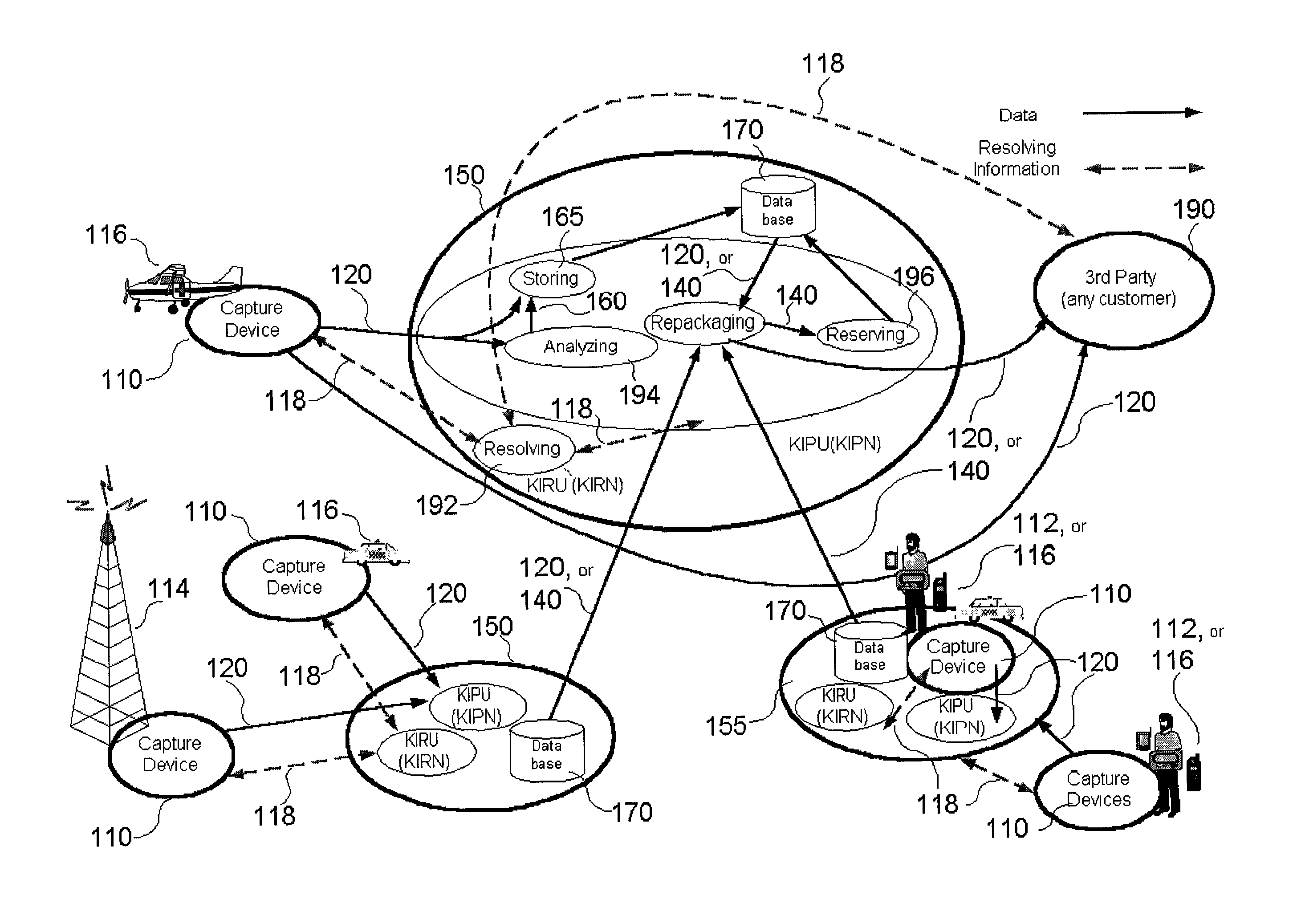Collecting, analyzing, consolidating, delivering and utilizing data relating to a current event
a technology of current events and data collection, applied in the field of collecting, analysis and consolidation of data, can solve the problems of long time delay between the time, inability to collect, and limit the capacity that can be marshaled (budget, technology, training, etc.)
- Summary
- Abstract
- Description
- Claims
- Application Information
AI Technical Summary
Problems solved by technology
Method used
Image
Examples
first embodiment
[0033]FIG. 1 illustrates a first embodiment, which is a method for capturing and utilizing data. The method for capturing and utilizing data provides at least one data capture device (110) that is provided to at least an individual (112) or mounted on at least a structure (114) or mobile platform (116); resolves legacy system data and appetite requests (118) and captures new, unique raw data (120) from the data capture device (110) in the proximity of a current event, and / or a nearby potentially affected site, wherein incoming data includes the captured raw data (120) and / or repackaged data (140) from the source inputs. The repackaged data (140) is value-added data. Captured raw data (120) is sent to a centralized command center or distributed command center (150) which has at least one centralized server or distributed server for processing to resolve which portion of the data is required to go forward. Captured raw data (120) and analyzed data (160) are then stored in a storing se...
second embodiment
[0056]FIG. 3 is a schematic diagram of a second embodiment in which sensors work in concert with command or data centers to capture and utilize data. The same or similar features of each embodiment of the inventions operate in the same or similar fashion as those of the other embodiments, unless stated otherwise so as not to be repetitive. The arrangement for capturing and utilizing data comprises: at least one sensor (310) for measuring data that may relate to an emergency condition, capturing data from a current condition, using the at least one sensor (310) to capture data (320) in the proximity of a current event or condition—wherein the incoming data includes raw data (320) and / or repackaged / value-added data (340) from source inputs, sending the captured data (320) to a centralized and / or a distributed command center (350) with centralized and / or distributed server processing, storing the raw and analyzed data (365) in a database (370), repackaging the captured data (320) with ...
third embodiment
[0061]FIG. 4 is a schematic diagram of a This embodiment shows an arrangement for analyzing data comprising: providing at least one Information Processing Network (see FIG. 2, (230)) that dynamically networks together a series of Information Processing Units (425) across a plurality of centralized and / or distributed database servers (470), and an Information Resolution Network (see FIG. 2, (255)) that dynamically networks together a series of Information Resolution Units (450, only one KIR is shown on this figure) across a plurality of centralized and / or distributed database servers (470). Incoming data is automatically analyzed. The incoming data includes raw data (410), and / or repackaged (425) / value-added data (425) from in formation source inputs. An incoming data entity information table (445) is created. The subscriber requests are collected, creating a subscriber request data entity information table (440). The KIR Processing Unit resolves the data entity table and the subscr...
PUM
 Login to View More
Login to View More Abstract
Description
Claims
Application Information
 Login to View More
Login to View More - R&D
- Intellectual Property
- Life Sciences
- Materials
- Tech Scout
- Unparalleled Data Quality
- Higher Quality Content
- 60% Fewer Hallucinations
Browse by: Latest US Patents, China's latest patents, Technical Efficacy Thesaurus, Application Domain, Technology Topic, Popular Technical Reports.
© 2025 PatSnap. All rights reserved.Legal|Privacy policy|Modern Slavery Act Transparency Statement|Sitemap|About US| Contact US: help@patsnap.com



